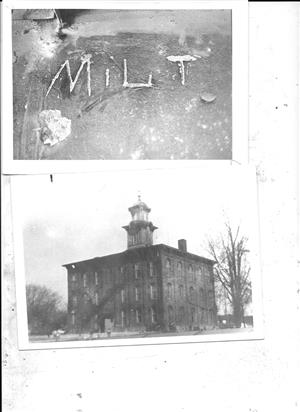- Cardington-Lincoln Local Schools
- District History
About our District
Page Navigation
-
History of Cardington Schools
From: Evelyn Long
History of the Cardington (Lincoln) School
The first Cardington settlement was in 1822. It was 1823 when they formally organized and the concern of the parents about the education of their children led to the first organized school when a log cabin was built in Cardington Township northeast of the village. The next year, 1824 a log school was constructed just west of where the railroad crossed the river behind the now closed Dreamland Theater building on West Main Street. The site was chosen because of the nearby spring. The early school was long, daubed with mud, and greased paper for window lights. Crude benches made from split logs served as the seating for students. The first teacher was Slocum Bunker and the first female teacher was Sarah Howard.
The school was later moved to the old cemetery lot and then to a lot on East Main Street owned by Anson St. John. All were of log construction.
The first frame building was erected in 1840 on the corner of Second and Center Streets and was used both as a school and a church. For 13 years, it was the only school in the village. A second frame building, constructed in 1853, was used as a school for 15 years before being sold in 1868 and converted into a two-family dwelling. Located on East Walnut Street, two houses west of Center Street, it remains a residence today, having undergone total renovation.
The Union School
The first brick building was an impressive structure, the most modern building of its kind in Morrow County. The Union School was built in 1868 on Nichols Street, then a dirt street, at a cost of $40,000, which included equipment and ground grading. It was about this time that the one room schools in the area were closing and those students were enrolled in the nearest area facility.
The Union School was used continuously until 1924, when a new structure was built on the same site. Walls of the old building were incorporated into the high school section of the building. The total cost was $135,000 and the dedication was held April 3, 1925. In 1939, a four classroom addition and an agricultural building were added behind the school.
Expanding once again in 1952, another addition was built at a cost of $374,806. This addition to the east end of the building included a two-story section with eight classrooms, four rest rooms and an auditorium-gymnasium.
The Fulton School, Lincoln Township, was annexed to the Cardington School District in 1964 when it became the Cardington-Lincoln School District.
The Fulton School, which once functioned from a frame building on Williams Street, housed students in all 11 grades until 1934, when seniors completed high school at Mount Gilead. That same year, Fulton freshmen chose to complete their high school either in Mount Gilead or Cardington.
Larger enrollment in Fulton necessitated the construction of a new brick building in 1956 on ground located on West Main Street and purchased from
Richard Pearl. There were four classrooms and a gymnasium in the building which was used by students in grades 1-8 until the annexation, when it housed the district’s first grade students only.
With increased enrollment in the district, more classroom space was needed. Thirty acres of ground on State Route 529 east of Cardington were purchased from Virgil Shaw and in 1967 the new high school building was completed at a cost of $765,966.
The one-story structure contained 17 classrooms, two shops, one gymnasium and one cafeteria. It housed grades 9-12 and the class of 1968 was the first to graduate from it. A swimming pool and tennis court were built adjoining the property to the west.
With a continued increase in enrollment, the facilities changed again in 1992 and a $4.6 million renovation and new construction project were completed.
This project included the extensive remodeling of the Nichols Street building, which was then the home of students in grades two through eight. The renovated building now accommodates students in grades pre-school through four.
The small original gym was remodeled into an elementary library, and the cafeteria was redesigned and a new food preparation kitchen was built.
Traffic patterns in the school itself were greatly improved, allowing students to move through the various building additions (1925, 1939 and 1952) with ease. A new main entrance and lobby were also added.
The building, originally built as an agricultural building, was then used by the music department and was converted into the district’s board office.The superintendent’s and treasurer’s offices were moved to this building.
Kindergarten students who had been attending school in area churches for the previous 20 years, were brought into the newly remodeled building and likewise, the first grade students who had been attending school in the four-room Fulton building, were brought to the Cardington facility.
The Fulton building was donated to the village of Fulton.
Meanwhile, at the high school site, a 34,000 square foot middle school addition was built onto the high school building in
The addition included 13 new classrooms, a new gymnasium, a music room and library to accommodate students in grades 6-12. Administrative offices were remodeled into a computer lab and two classrooms. The cafeteria was doubled in size, with an additional food preparation area. Provisions for the recent innovations in technology were also made in each building. The completion of this project provided the district with the most up-to-date facilities in Morrow and surrounding counties and helped stimulate a rebirth of pride among the residents of the school district.
In the Fall of 2002, a levy was passed with a small mill rate, triggered by around $1.3 million or more from the state of Ohio to build the new intermediate building, renovate and add to the high school/middle school building and renovate and add to the elementary building. In the spring of 2003, an approximate one mill levy was passed to convert the high school gym into the current Patrick Drouhard Auditorium. Because that space consumed the gym, the state agreed to build a new gymnasium for the district. Cardington was the only district in the state of Ohio that was permitted to do that. Both levies passed easily by voters.
The intermediate building was completed in the Fall of 2005 and the high school, a year later, in the Fall of 2006. Renovations and additions to the elementary were completed by January 2007. Former Superintendent Pat Drouhard commented, “When all was said and done, the district had state of the art school facilities.”
In the Fall of 2013, the district consolidated school building assignments, moving the fourth grade back to the elementary and grades 5-6 to the high school /middle school building. The measure allowed for the district to save on operational costs and eventually, in 2015, the district was able to open the
building back up to tenants including Goal Digital Academy, Rising Stars Dance Studio, Ohio Heartland Head Start and the Tomorrow Center. The district is further exploring opportunities to utilize the space once again for district programming, including additional Career Technical Education programs.
The Tomorrow Center, a community school that specializes in leading at risk students to graduation, serves as an integral part of improving the graduation rate for students in Marion and Morrow Counties.
Jon Mason, district treasurer, stated that $12,219,950 was spent in the fiscal year which ended June 30, 2019. There was $1,689,644 in the general fund balance at the fiscal year's end. Compare that to 1988 when the appropriation budget for the district was $2,922,444 and the FY 2000 expenditures were $5,947,987 for the district.
The district serves an area of 85 square miles. Open enrollment allows students to attend school from the surrounding area.
Cardington-Lincoln School’s two athletic fields and three gymnasiums have been named in honor/memory of residents or alumni who contributed their time and talents to the school. The athletic field on Nichols Street was named in memory of Dick Pace, Class of 1944; the gymnasium is called the Patterson Gym in memory of Lowell Patterson, Class of 1925; the football field at the high school is called Merle Fisher Field in memory of Mr. Fisher, Class of 1930, and the high school gym is called the Murphy Gym in memory of Dr. Lowell Murphy, who was the athletic team doctor for many years during his 37 years of medical practice in the village.
The Middle School Gym was named the Gerald Goodman Gym in memory of Mr. Goodman who was active with the school’s sports department and he was also a school bus driver for many years.
There have been 17 superintendents of the district and one interim administrator. They are G. O. Brown, A. I Banker, R. H. Morrison, L. I. Morse, N. D.
O. Wilson, F. H. Flickinger, Walter J. Bankes, W. I. Atwell, J. J. Almack. C. M. Beitler, Roland Thompson, J. Cline Slack, J. L. Patterson, William Hall, Frank Cocharn (interim adm.) George Nash, Frank Perry and Patrick Drouhard, who retired in 2002 when Mark Wilcheck became the superintendent. Following Wilcheck’s resignation in December, 2008, Patrick Drouhard was named the interim superintendent, serving from December, 2008 to July, 2010, when Brian Petrie became the current superintendent.
Graduates who have given the ultimate sacrifice while serving their country during armed conflicts include Lawrence Philbrook, Class of 1914; Myron Caris, Class of 1915; (World War I); Major Leo V. Ault, Class of 1906; Lt Col Ralph Lowther, 1934; S/Sgt Curtis Ogg, Class of 1937; Capt. Richard Jones, Class of 1938; Lt John Vaughan, Class of 1939; Lt Stanley Shaw, Class of 1930 (World War II) and Pfc. Edgar Shoults, Class of 1947, Korean War.
Many graduates have returned to teach at their alma mater after they earned their diplomas from their colleges and universities. Lowell Patterson, Class of 1925, returned as a teacher, then high school principal and superintendent.
Several teachers shared their memories of first attending school in the Union School and then teaching in the current building. Carrie Philbrook,
Emma Schwartz Joy, Eilene Messenger Ulery, and Mary Margaret Farrington Byrd, all deceased, are just a few who have shared their experience with their alma mater as both student and teacher. Carrie graduated from the Union School; the others named graduated from the renovated school.
The school has had an active alumni program since 1930 and today the association awards over $2000 annually in scholarships to current graduates.
Because they demonstrated support for the Cardington-Lincoln School District, the following have been named honorary members of the Cardington-Lincoln Alumni Association:Claude M. Beitler, Superintendent,
Rolland Thompson, Principal;
A.W. (Dad) Carter, beloved Custodian;
Wilbur McAlister, Teacher/Principal;
Mary McAlister, Grade School Teacher;
Patrick Drouhard, Superintendent
Brian Petrie, Superintendent.


